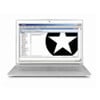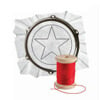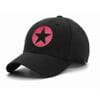Embroidery
is the art of working raised and ornamental designs in threads of silk, cotton, or other material, upon any jersey, fleece, piqué or other types of fabric, with a needle or an embroidery machine.
- EMBROIDERY PROCESS: Today’s custom embroider is a primarily automated process. A sewing program translates the digital artwork into data. This process, known as that digitizing, guides the machine to sew the artwork on to the garment.
 DESIGN AND DIGITIZE IMAGE: Create or adapt a design for embroidery, bearing in mind that simpler designs with open areas translate best into stitches. Designs with open areas will allow fabric to drape more naturally. Once complete, the design must be digitized to translate it into stitch data for the sewing machine. This may be done in-house using software compatible with your embroidery machine, or outsourced to a reputable digitizing firm. If outsourced, please ensure that the digitizer knows the type of garment so that the digitizing (embroidery) program takes that into consideration. Other important considerations include the type of backing being used inside the garment and materials which maybe placed on top of the garment since these can impact the end result. Send the digitized image to your embroidery machine.
DESIGN AND DIGITIZE IMAGE: Create or adapt a design for embroidery, bearing in mind that simpler designs with open areas translate best into stitches. Designs with open areas will allow fabric to drape more naturally. Once complete, the design must be digitized to translate it into stitch data for the sewing machine. This may be done in-house using software compatible with your embroidery machine, or outsourced to a reputable digitizing firm. If outsourced, please ensure that the digitizer knows the type of garment so that the digitizing (embroidery) program takes that into consideration. Other important considerations include the type of backing being used inside the garment and materials which maybe placed on top of the garment since these can impact the end result. Send the digitized image to your embroidery machine. STABILIZE AND HOOP: Select the appropriate stabilizer for your item’s fabric, apply temporary spray adhesive, and smooth the stabilizer onto the item. Next, place all layers firmly in your embroidered machine’s hoop, which holds the fabric securely and moves as the item is sewn. The fabric should be smooth and flat, but not stretched out of its original shape. Insert the hoop into your embroidery machine.
STABILIZE AND HOOP: Select the appropriate stabilizer for your item’s fabric, apply temporary spray adhesive, and smooth the stabilizer onto the item. Next, place all layers firmly in your embroidered machine’s hoop, which holds the fabric securely and moves as the item is sewn. The fabric should be smooth and flat, but not stretched out of its original shape. Insert the hoop into your embroidery machine. STITCH THE DESIGN: Once you insert the hooped item and send your digitized file, the embroidering machine does most of the work. It will stop when it’s time to change thread or if other action is needed. When the machine finishes sewing, remove the hoop, unhoop the fabric, and trim any excess thread from the stabilizer. Some items may need a light steam pressing to smooth any creases caused by the hoop.
STITCH THE DESIGN: Once you insert the hooped item and send your digitized file, the embroidering machine does most of the work. It will stop when it’s time to change thread or if other action is needed. When the machine finishes sewing, remove the hoop, unhoop the fabric, and trim any excess thread from the stabilizer. Some items may need a light steam pressing to smooth any creases caused by the hoop.
EMBROIDERY EQUIPMENT AND SUPPLIES
- COMPUTER:A computer with specialized software that translates digital imagery, e.g., a GIF or JPEG, into stitch data to guide the embroidery machine, or the services of a digitizing company that will translate the image into stitch data for a fee.
- EMBROIDERY MACHINE: A wide range of machines are capable of doing embroidery, ranging from low-cost, consumer-grade sewing machines to automated, multi-need industrial machines capable of producing complex, highly detailed stitched graphics.
- SUBSTRATE:Many fabric items are suitable for embroidery, from T-shirts and fleece to totes and hats. Very lightweight or highly elastic fabrics can be challenging to embroider, with a greater tendency to pucker or wrinkle. Plush fabric such as fleece require densely stitched embroidery to prevent the fabric from showing between stitches.
- STABILIZER:Even low-end home embroidery machines can make several hundred stitches per minute, putting tremendous strain on most fabrics. A stabilizer supports the fabric during stitching to prevent shifting, stretching or distortion.
Previous
Direct to Garment
Next
Econscious